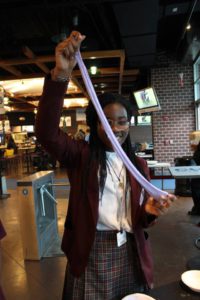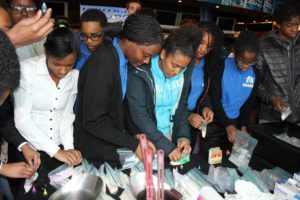Hands-on Activity #1: Carbon Captured Chalk Experiment
 Goal: The premise of this experiment is to help students identify the means to sequester carbon dioxide. A double substitution reaction is used by chemical engineers to help relieve the burden of carbon dioxide on our atmosphere by trapping emissions in benign products, such as chalk.
Goal: The premise of this experiment is to help students identify the means to sequester carbon dioxide. A double substitution reaction is used by chemical engineers to help relieve the burden of carbon dioxide on our atmosphere by trapping emissions in benign products, such as chalk.
Two solutions of soluble salt (Sodium bicarbonate and Calcium chloride) are mixed and undergo a double substitution reaction. As a result, table salt (sodium chloride) and chalk (calcium carbonate) are formed. Students will begin to understa
nd the importance of carbon sequestration technology, define heats of solutions and further grasp the concept of solubility.
Hands-on Activity #2: Slime Experiment
 Goal: This exciting experiment seeks to introduce the concept of polymer formation through the cross linking of glue with borax to form slime.
Goal: This exciting experiment seeks to introduce the concept of polymer formation through the cross linking of glue with borax to form slime.
Students are introduced to how the order of experiment design plays a critical role in the final outcome of the product. For instance, what happens when you add too much borax to the glue solution? Or what happens when you add the borax too quickly to the glue solution? When do you color your slime with food coloring? What is cross-linking? What is a polymer?
Hands-on Activity #3: Homemade Ice Cream Experiment
 Goal: This delicious experiment is a hands-on engineering classic whereby students get to explore the concept of freezing point of depression through the use of rock salt to lower the freezing point of ice. The lower temperatures formed is then applied to freeze delicious liquid cream into ice cream.
Goal: This delicious experiment is a hands-on engineering classic whereby students get to explore the concept of freezing point of depression through the use of rock salt to lower the freezing point of ice. The lower temperatures formed is then applied to freeze delicious liquid cream into ice cream.
Students get to explore the creative side of engineering through a mixture of food coloring in their plain liquid cream and the application of rock salt in everyday life for temperature control? Why is rock salt applied to driveways and bridges when it is about to snow heavily? What causes the temperature of ice to drop below freezing when rock salt is added? In addition to this experiment, the concept of heat transfer is introduced through convection, conduction and radiation.
Hands-on Activity #4: Lip Gloss Experiment
 Goal: The goal of this experiment is to excite the young minds to consider how chemical engineering extends to consumer products such as lip-gloss. This engaging hands-on experiment gets the young minds thinking about how cosmetics and consumer products are carefully analyzed and thought through to ensure that its chemical properties are safe, stable and appeal to the general public. For example, no one wants to use a lip gloss that is too hard or too oily. This why lip gloss calls for some sort of oil or butter with the help of emollients to moisturize and soften the skin. On the other hand, beeswax is introduced to avoid having lip gloss that is too runny at room temperature. Students get to explore that the perfect lip gloss means getting the right ratio of emollients to waxes.
Goal: The goal of this experiment is to excite the young minds to consider how chemical engineering extends to consumer products such as lip-gloss. This engaging hands-on experiment gets the young minds thinking about how cosmetics and consumer products are carefully analyzed and thought through to ensure that its chemical properties are safe, stable and appeal to the general public. For example, no one wants to use a lip gloss that is too hard or too oily. This why lip gloss calls for some sort of oil or butter with the help of emollients to moisturize and soften the skin. On the other hand, beeswax is introduced to avoid having lip gloss that is too runny at room temperature. Students get to explore that the perfect lip gloss means getting the right ratio of emollients to waxes.
The concept of emulsifiers, like Vitamin E, to change the properties of one ingredient so that they become microscopic droplets inside the other is also introduced.
